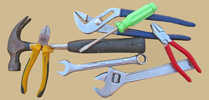The Key to Replacing an Existing Lock Set
If you have a dysfunctional or out dated door lock set, replacing it can be an easy and cost effect way to improve the look and functionality of your existing door. The two basic types of residential lock sets are commonly referred to as either mortise or standard. Older homes usually have mortise type lock sets which can be identified by the extra long rectangular metal inset on the side of the door. These can be replaced with a standard type knob, though you will need to fill the gap inside the door with a piece of custom cut lumber and some wood putty.
Step 1: Identify the lock set size by measuring the thickness of the door and the length of the back set. The back set is the area that goes from the side of the door to the handle and contains the latching mechanism. Most, but not all, lock sets come with an adjustable back set that will accommodate both 2-3/8” and 2-3/4”applications. Make sure the lock set you choose will fit your needs.
Step 2: Remove the old lock set by first unscrewing or prying off the trim rings on either side of the door. There may be two long screws holding the door handles in place beneath the trim ring. If so, unscrew these and remove the handle set.
Step 3: Remove the old latch by unscrewing the two screws on the face plate located on the side of the door. Pull out the latch and compare it to the new latch. If necessary, adjust the new latch so it is the same length as the old latch.
Step 4: Check the back set hole size to make sure the new latch will fit. Refer to the lock set instructions if the existing hole is slightly larger, chances are you will find an adjustable collar for the latch.
Step 5: Install the latch with the slant of the bolt facing in the direction that the door closes. Tighten the face plate screws, making sure the latch is level inside the door.
Step 6: Insert the new knob with the stemmed assembly onto the door and through the latch opening.
Step 7: Attach the other knob to the stemmed knob, being sure to align the installation screws. Tighten the screws gradually, alternating between the two so that the knobs are aligned evenly.
Step 8: Test the new lock set to make sure the latch and knobs move freely and the locking mechanism works smoothly. Readjust the lock set and latch if necessary.
Step 9: Replace the old strike plate on the door jamb with the new strike plate. Reposition it if necessary to assure the door latches securely. Be sure the lock set is working properly before shutting the door.
Put away your tools, recycle the old lock set and replace the key on your ring with the new key. Don’t forget to put a copy in a safe place. Now smile and relax knowing you are just a little bit safer and a little more stylish with your new lock set.
Standard lock sets are available in a wide range of styles and finishes.
Email us at info@you-can-fix-it.com to request new fix-it ideas. We also encourage you to add comments or suggestions below each article.
| You-Can-Fix-It.com
|


Leave a Reply